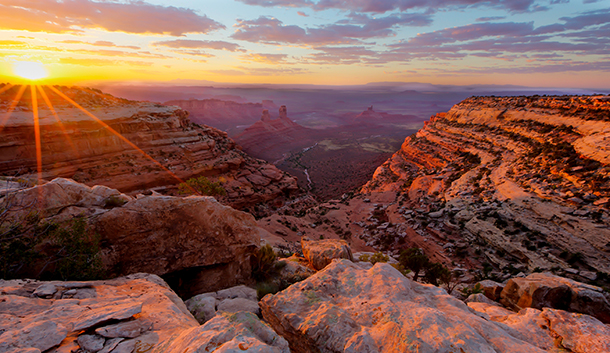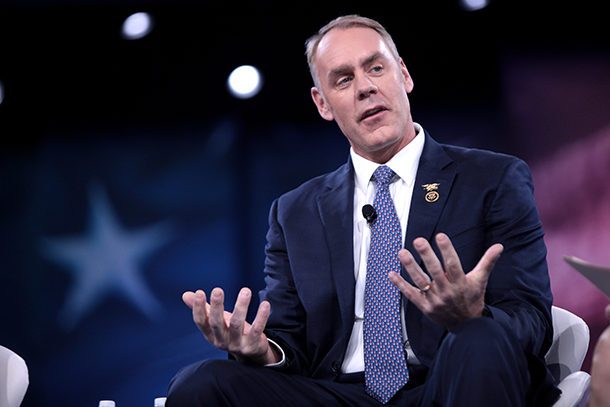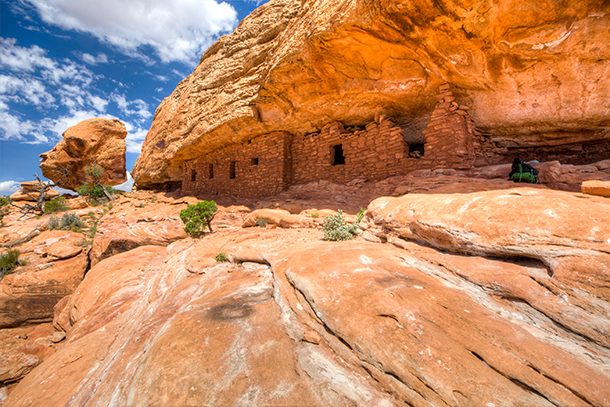Shrinking Bears Ears
Air Date: Week of June 16, 2017

Bears Ears was granted National Monument status in 2016 and encompasses 1.3 million acres of land in southern Utah. (Photo: Bureau of Land Management, Flickr CC BY 2.0)
Interior Secretary Ryan Zinke’s interim report recommends that Bears Ears National Monument’s 1.3 million-acre area be shrunk. The Antiquities Act that allows Presidents to create National Monuments but has no mechanism for Presidents to reduce or undo them. Bears Ears National Monument contains many sacred and historical sites for Native Americans and Living on Earth host Steve Curwood and Tracy Coppola, a Senior Legislative Counsel with Earthjustice, discuss the politics at play and the future for Bears Ears.
Transcript
CURWOOD: From PRI, and the Jennifer and Ted Stanley Studios at the University of Massachusetts Boston, this is Living on Earth. I’m Steve Curwood.
The Trump Administration has fired another shot in the long-smoldering Sagebrush Rebellion, this time with a preliminary recommendation from Interior Secretary Ryan Zinke that the 1.3 million acre Bears Ears National Monument should be shrunk and perhaps fragmented.
Since the 1970’s rightwing activists and lawmakers in the Western States have called for more state and local control of the vast federal acreage in the region, seeking more access for mining, drilling and cattle grazing. And when President Trump came into office he ordered a review of all national monuments decreed since 1996. There are racial overtones. President Obama created Bear’s Ears monument at the end of his term in response to concerns of Native Americans who have deep spiritual and cultural ties to the area.
Tracy Coppola, a Senior Legislative Counsel at Earthjustice joins us now from Washington D.C. Welcome to Living on Earth Tracy!
COPPOLA: Thanks so much for having me.
CURWOOD: First, from your perspective, why is Bears Ears National Monument of particular importance?
COPPOLA: When you think about Bears Ears, you just think about how sacred that land is. It has a remarkable amount of archaeological, cultural sites, over 100,000 Native American treasures, ancient dwellings, pre-historic ruins. It's an amazing place to recreate and to really celebrate public lands, so this is very much a treasured land that I think we all love and celebrate.
CURWOOD: Why did President Trump ask Secretary of Interior Ryan Zinke to look at Bears Ears? There's some 27 national monuments that he asked him to review, but in particular he asked him to review this first and with a short turnaround on his report.

Interior Secretary Ryan Zinke is currently reviewing 27 National Monuments following an Executive Order by President Trump. (Photo: Gage Skidmore, Flickr CC BY-SA 2.0)
COPPOLA: This was clearly a political strategy on the Trump administration. They had been hearing from the Utah delegation who really didn't want to see this land as a National Monument. Definitely there are industry interests that are chomping at the bit to tear apart this land. Certainly, what the president and his administration wasn't looking at was, all the folks on the ground and of course the historic partnership of the intertribal coalition that wanted to see this land protected.
CURWOOD: Now, some folks in Utah would say, “Wait a second. There's a lot of protected lands in this general area.” There's Grand Staircase. Escalante, that's a National Monment. You go north of there, there's Capital Reef, that's a national park. How fair is that assessment by the locals there in Utah that there's just too much land being protected?
COPPOLA: Well, when you think about Bears Ears, you look at what would this land be without the national designation, and the sacred value of this land can't beat overstated. I mean, this is home to ancient cliff dwellings and Native American cultural sites and, not to mention, wildlife, but also it was being looted, there was grave robbing, vandalism. So, it desperately needed protection.

Native American dwellings and petroglyphs are abundant in the Bears Ears National Monument. (Photo: Bureau of Land Management, Flickr CC BY 2.0)
CURWOOD: So, Secretary Zinke says he's not recommending that President Trump try to revoke the National Monument status of Bears Ears, but rather that it should be "right sized". What does that mean exactly? What's he talking about?
COPPOLA: What it looks like is, there's going to be a significant reduction in the size of this monument, and from what the recommendation looks like, it's going to be so parceled-out or so shrunk that it's really going to be an insignificant protection. So, I think that there's a lot at risk here, and we always say, an attack on one is an attack on all.
So, this not only would be very tragic for Bears Ears and the stakeholders and the tribes that have fought for years for this designation, but really it would be an affront to all public lands lovers and really all Americans because this is all our land.
CURWOOD: So, what kind of precedent is there for shrinking or removing a National Monument?
COPPOLA: So, there really is no precedent for a president to remove or revoke a National Monument, and no president actually has attempted to, for good reason. Legal scholars and others are in agreement that no president has the legal authority to eliminate or significantly alter a National Park or a National Monument. Really that's something that only Congress has the authority to do.
So, this entire process, which really has been a very strange process in that the Bears Ears National Monument -- We only had 15 days at first to comment. That's an incredibly short time for a National Monument comment. It really is an unprecedented time -- and so far between EarthJustice and several other national groups, over one million comments have been collected, and for Bears Ears alone, we almost had 700,000 comments. That's a historic amount of comments for 15 days, all in support of the Monument.
CURWOOD: So, President Trump asked for this review. As you say, the president doesn't have the power to shrink or even revoke a National Monument, but the Congress certainly does. To what extent are you concerned that Secretary Zinke’s review will wind up in a bill that will then be presented in Congress? What is the risk that legislation to either shrink or even revoke the National Monument status of Bears Ears could get through?
COPPOLA: Well, it's definitely something that we've been seeing for a number of Congresses, that there've been a lot of bills introduced to sell off public lands. If that does happen, I do think that even at a bipartisan level there's an overwhelming support for these lands, but, you know, here in DC we see on a weekly basis these type of threats on our public lands. I think that it’s going to be a challenge for such a bill to even go through. It would face a lot of opposition.

Tracy Coppola is a Senior Legislative Counsel with Earthjustice and has been closely following the Interior Department review of the Bears Ears National Monument. (Photo: courtesy of Tracy Coppola)
CURWOOD: Tracy, before you go, tell me, what comes next?
COPPOLA: Well, we have a public comment that ends on July 10th, and that is for all of the National Monuments that the executive order included and that also now includes Bears Ears. After that, at the end of August, we're going to see a report from Interior on the 26 Monuments at stake, and that we'll have recommendations to the president and then we'll see. EarthJustice has put it out there that if Trump follows Zinke’s recommendation to shrink Bears Ears, we're going to see him in court because this is illegal, and also the public needs to know about it.
CURWOOD: Tracy Coppola is Senior Legislative Council at EarthJustice in Washington. Thanks so much for taking time with us today.
COPPOLA: Thank you so much.
Links
NY Times: “Interior Secretary Recommends Shrinking Borders of Bears Ears National Monument:”
President Trump's Executive Order calling for a review of National Monuments
Living on Earth wants to hear from you!
Living on Earth
62 Calef Highway, Suite 212
Lee, NH 03861
Telephone: 617-287-4121
E-mail: comments@loe.org
Newsletter [Click here]
Donate to Living on Earth!
Living on Earth is an independent media program and relies entirely on contributions from listeners and institutions supporting public service. Please donate now to preserve an independent environmental voice.
NewsletterLiving on Earth offers a weekly delivery of the show's rundown to your mailbox. Sign up for our newsletter today!
 Sailors For The Sea: Be the change you want to sea.
Sailors For The Sea: Be the change you want to sea.
 The Grantham Foundation for the Protection of the Environment: Committed to protecting and improving the health of the global environment.
The Grantham Foundation for the Protection of the Environment: Committed to protecting and improving the health of the global environment.
 Contribute to Living on Earth and receive, as our gift to you, an archival print of one of Mark Seth Lender's extraordinary wildlife photographs. Follow the link to see Mark's current collection of photographs.
Contribute to Living on Earth and receive, as our gift to you, an archival print of one of Mark Seth Lender's extraordinary wildlife photographs. Follow the link to see Mark's current collection of photographs.
 Buy a signed copy of Mark Seth Lender's book Smeagull the Seagull & support Living on Earth
Buy a signed copy of Mark Seth Lender's book Smeagull the Seagull & support Living on Earth

